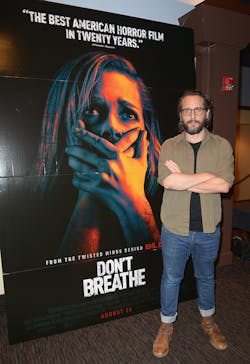HVAC in Popular Movies: Did Hollywood Get It Right? 'Don't Breathe' Edition
Editor’s note: Hollywood long has been known for—ahem—taking liberties with the truth (just ask any composite character). In HPAC Engineering’s ongoing series “HVAC in Popular Movies: Did Hollywood Get It Right?," Ron Wilkinson, a professional engineer who moonlights as a film critic, takes a look at movies and television series whose makers may or may not have let HVAC fundamentals get in the way of a good story.
Don't Breathe (2016)
In this low-budget sleeper hit co-written and directed by up-and-coming filmmaker Fede Alvarez, three delinquents—Rocky (Jane Levy), her boyfriend, Money (Daniel Zovatto), and their friend Alex (Dylan Minnette)—think they are in for an easy score breaking into the home of a blind man. As it turns out, the blind man is a savvy—and psychotic—war vet (played to the hilt by Stephen Lang, Col. Quaritch in “Avatar”). Despite his disability, the blind man is a pretty good shot and not bad with a knife, poker, or pruning shears. When he hears the ruckus at his safe, he runs out, firing a clip at a time. Thank goodness the neighbors are sound sleepers. Money is killed, and Rocky and Alex flee through the house as grisly secrets are revealed.
When the blind man is down, his foaming-at-the-mouth attack dog takes over. Rocky jumps through a grille, which leads to the attic and back down to the cellar, for some strange reason. This is not a sheet-metal duct, but an old, filthy, mildewed wooden duct that was built into the house—to ventilate the basement into the attic, or the attic into the basement, or the basement and attic into the living room. Maybe it is a fire escape for the basement rats. It is hard to say.
But, boy, are we glad it’s there. Rocky crawls at full speed through the splintered chase with the attack dog nipping at her heels. In the duct. He is slavering and slobbering so much he can hardly get traction and snapping and chewing so insanely you think he is going to eat the ancient 2x4s. Excellent cinematography by Pedro Luque filming the chase through the rotting passage.
In the end, the cops come, the psycho gets his (or so it seems—a sequel described as, “The Blind Man returns to terrorize more unsuspecting people,” has been announced), and, one imagines, the house is sold to a young couple who replace the chase with a mirror-light duct and the dog gets his own Facebook page and enters seeing-eye service in Florida.
Snubbed for Oscar nominations were lenser Luque for best cinematography in a filthy, rotting duct layered with dog slime and the attack dog (played by three canines: Athos, Astor, and Nomad) for best performance with slimy, snarling, foaming jowls. Be there or be breathless.
Check out the movie's trailer below.
About the Author
RON WILKINSON PE LEED AP CPMP
Principal
The founding principal of Seattle-based Wilkinson Commissioning Management, Ron Wilkinson, PE, LEED AP, CPMP, is the author of the first commissioning training program for the Leadership in Energy and Environmental Design (LEED) for New Construction and Major Renovations Green Building Rating System and the founding recording secretary for ASHRAE Guideline Project Committee 0.2/1.2, The Commissioning Process for Existing Building Systems and Assemblies/The Commissioning Process for Existing HVAC&R Systems. An ASHRAE Distinguished Lecturer and an American Institute of Architects Continuing Education Lecturer, he has spoken on commissioning practices internationally. He is a longtime member of HPAC Engineering’s Editorial Advisory Board.

